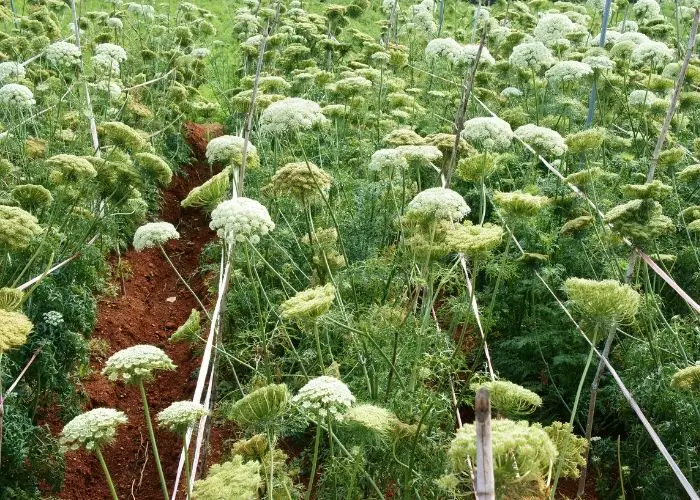Last Updated on October 28, 2022
Are you wondering what do carrot plants look like? We have all the details that you need to know about growing carrots.
Growing carrots is a wonderful experience for any gardener. But it could be challenging if you cannot identify their leaves immediately after sprouting.
Most gardeners fail to know what do carrot plants look like immediately after sprouting and may confuse them with grass.
So how do you know how to identify these plants from the time they sprout till they bloom? If you stick here, we have all the details you ought to know.
What Does A Carrot Plant Look Like When It Starts Growing?
Most gardeners do not have a problem identifying a grown carrot plant, but they don’t know what carrot plants look like when they sprout. So what do carrot sprouts look like?
Once sown, a carrot seed takes about 2-3 weeks to germinate. Once it germinates, you will see tiny grass-like sprouts. These are also known as carrots seedlings. They have a fine texture, but after a few days, the leaves thicken up, and they become easy to identify.
What Do Carrot Plants Look Like? Differentiate Carrots Sprouts From Grass
If you sow your carrot seeds where grass or weeds grow, it may be slightly tough to spot them. The carrot leaves usually germinate from a single spot and look smoother and silkier with a delicate texture.
When looking for carrot sprouts, a simple trick is to smell the baby leaves. Pinch a tiny part of the leaf and smell – they will smell similar to carrots.
Sowing tip: Mark the area where you sow your carrot seeds. This way, you will be able to identify your sprouts easily. You can also make a raised bed specifically for your carrot seeds or grow them in containers.
What Color Is A Carrot?
In addition to the popular orange color, carrots can also be red, purple, white, or yellow. Before the 16th Century, all carrots were a deep, black purple. The Dutch growers later developed the sweet, plump orange carrot that became so famous you would think it was the first to be cultivated.
Today carrots are available in a rainbow of colors – white, purple, red, yellow, and orange. Multi-colored carrots are still rare in most grocery stores but check out your gardening neighbors or the next farmer’s market this summer, and you will see a variety of these colors.
So that you know, rainbow-colored carrots taste different from ordinary orange carrots. Yellow carrots have an earthy-sweet flavor like parsley or celery. White carrots are quite mild. Purple carrots can have a peppery flavor that can also be very sweet.
What Do Carrot Flowers Look Like?
Carrot flowers are usually white and lacy, although purple carrot varieties have purple flowers. Being an umbel-type flower, it begins as a single stalk and grows into a bowl-shaped bloom with smaller stalks on top. The smaller stalks will then produce little white flowers at their ends.
Should You Allow Your Carrots To Flower?
A flowering carrot signifies that your plant has bolted and is not good to eat. That’s why you will not see gardeners leaving their carrots to flower. They harvest them young and fresh when they are full of flavor.
Flowering carrots will soon produce a batch of seeds meaning its overgrown. Flowering may also occur prematurely if the plant is growing under warm weather. Warm weather tricks the plant into putting energy into the flower rather than the root, causing white flowers to bloom and your carrot to bolt too early.
To keep your carrots from flowering, regularly sow carrots every couple of weeks during the season. Some of them will do well regardless of the weather changes.
How Do You Know When Carrots Are Growing?
Carrot seeds, once sown, are slow to germinate. They require lots of patience as it may take 2 to 3 weeks for them to show any signs of germination.
In a few more weeks, you will have many seedlings already germinated. At about 2 inches tall, thin to one plant every 4-6 inches. Instead of pulling them out and risking damaging the rest of the plants, snip them off at the soil level.
Provide your carrots with consistent water as they grow, about 1 inch per week. Mulch around the plants to keep the soil moist and weeds away. As the carrot roots grow and begin to push up from the soil, cover them with mulch to avoid discoloration from sunlight.
In warmer climates, you may be able to grow carrots through the winter by mulching them. However, in climates where the ground freezes and temperatures consistently remain under 32 degrees Fahrenheit, it’s best to harvest your carrots in late autumn.
Jobe’s Organics 09524 Purpose Granular Fertilizer
What Do Carrots Look Like When They Are Ready To Harvest?
What do carrot plants look like when they are ready for harvesting? The plants begin to turn yellow or brown slightly on the edges as a sign of maturity. When you decide to harvest your carrots, you will need to know if they are ready. It depends on the desired size of maturity of each person; some love them young and flavorful while others love them a bit large.
Carrots are ready for harvest 60-80 days after sowing seeds, depending on the variety. The tops are about 3/4 to 1 inch in diameter and are likely to start popping out of the soil. They also have a vibrant color. If you can see your carrots peeking at you from the ground, it’s time to harvest them. The smallest you want the carrots to be before harvesting is the size of your thumb, but you can grow them larger by letting them grow some more.
Carrots generally mature around the same time if you plant them together. However, you don’t have to harvest them all at once. You can leave some in the soil to preserve them if the weather is still pleasant. During winter, dig them up and store them in the refrigerator for future use.
FAQs
What should I consider when shopping for a Ph meter?
The most accurate way to measure pH is with a pH meter. The only problem with pH meters is that they are not cheap and they require some maintenance, but if you are doing research or have a large area to sample, then a pH meter is the way to go. The pH scale can vary by about 0.2 units from lab to lab and even more than that depending on the pH of the water used.
If you are using a meter that isn't calibrated, it will have an error. You can buy meters that are calibrated for your soil type and the amount of acidity in your area, but even these meters will not be perfect. A good calibration can help you determine the amount of acidity in your soil and also help you understand how to adjust the readings when you dig new holes.
What is the most accurate soil pH meter?
There are a variety of soil pH meters available on the market. Soil pH is one of the most common chemical analyses performed by a home or professional gardener. The most accurate soil pH meter will give you a more accurate reading, which in turn will provide you with an idea of what type of fertilizer to use.
Many of the soil pH meters available on the market are designed to be used by a professional who has access to a lab and is trained in the use of such equipment. However, there are many soil pH meters that can be used in the home, so it is important to know how to select one that will provide the best reading. There are many factors that go into choosing a soil pH meter for your home garden. First of all, you want to make sure that the meter can be used in the field. Some soil pH meters are designed to be used in the laboratory, while others are designed for the home gardener. Also, you want to make sure that you get a soil pH meter that will provide you with an accurate reading. A soil pH meter should give you a reading that is within one pH unit of the true pH value of the soil.
What makes the most accurate soil pH meters so accurate?
Soil pH is a measurement of how acidic or alkaline a soil is. The best soil pH meters measure the actual soil pH and then convert it into a pH number that you can see on your meter. Most people use a soil pH meter to find out what is causing their plants to be sick, and if they need to add some lime or sulfur to make the soil more acidic or alkaline.
The most accurate soil pH meter should be able to measure soil acidity or alkalinity in a wide range of soil types, and be able to measure the acidity of the soil at the depth where the test sample is taken. Soil pH testing requires knowledge of both soil chemistry and soil physics, as well as knowledge of how the pH meter is calibrated. It is also important to understand the limitations of using a soil pH meter.
Soil pH meters can be found in a wide range of prices and accuracy.
Take-Home
Besides learning what do carrot plants look like, we have also learned how to tell the sprouts apart from grass or weeds and how to grow carrots from seed to harvesting time.
Did you know you can grow your carrots in your small garden or pots on your patio? Yes, these rich vegetables can become a part of your gardening lifestyle due to their easy care and maintenance.
Remember to harvest your carrots when they are still fresh to avoid bolting. Once bolted, they get a bitter taste that is unpleasant to eat.

Lory is an avid gardener who loves spending time outdoors. She is passionate about using her green thumb to create beautiful, lush gardens for her friends and family. She finds joy in tending to her garden, trimming plants, and cultivating new species. She loves to share her knowledge and experience with others who have a similar enthusiasm for gardening. Lory is a true nature enthusiast who loves to share her enthusiasm for the outdoors with all who meet her.


